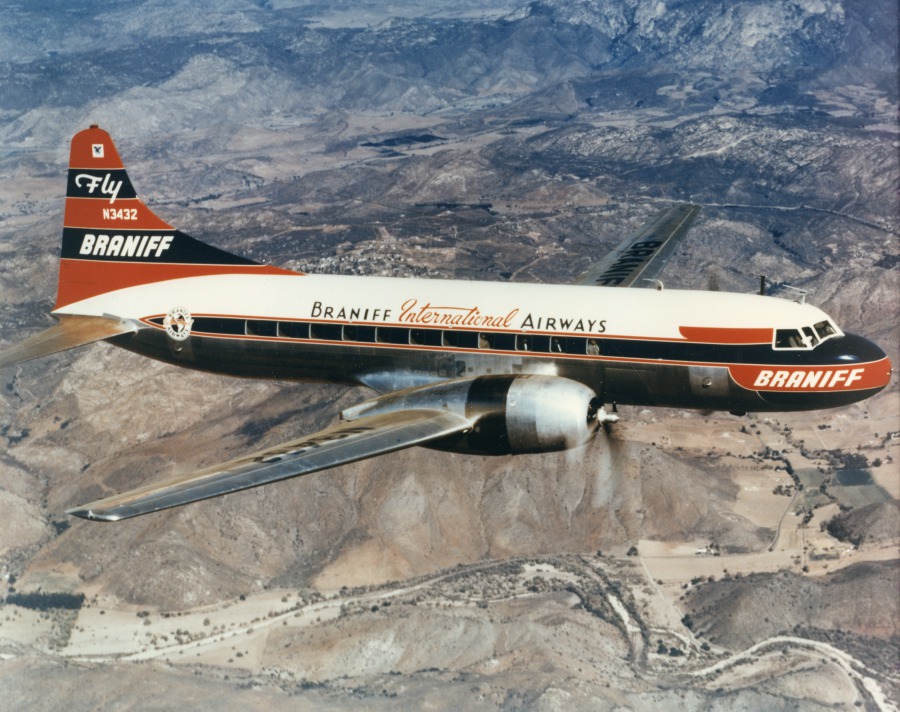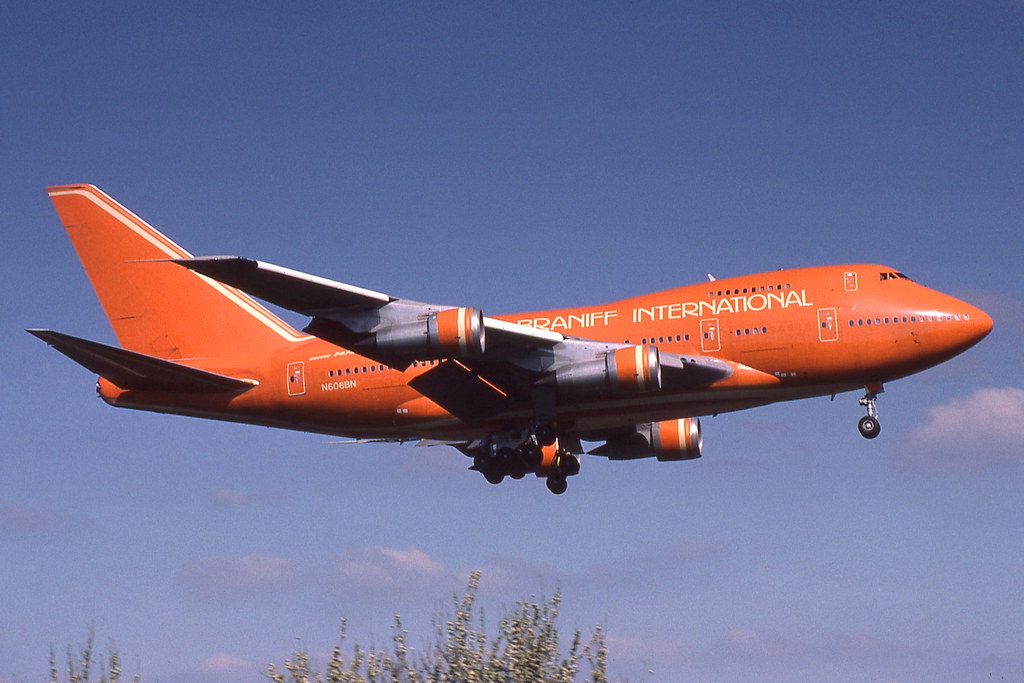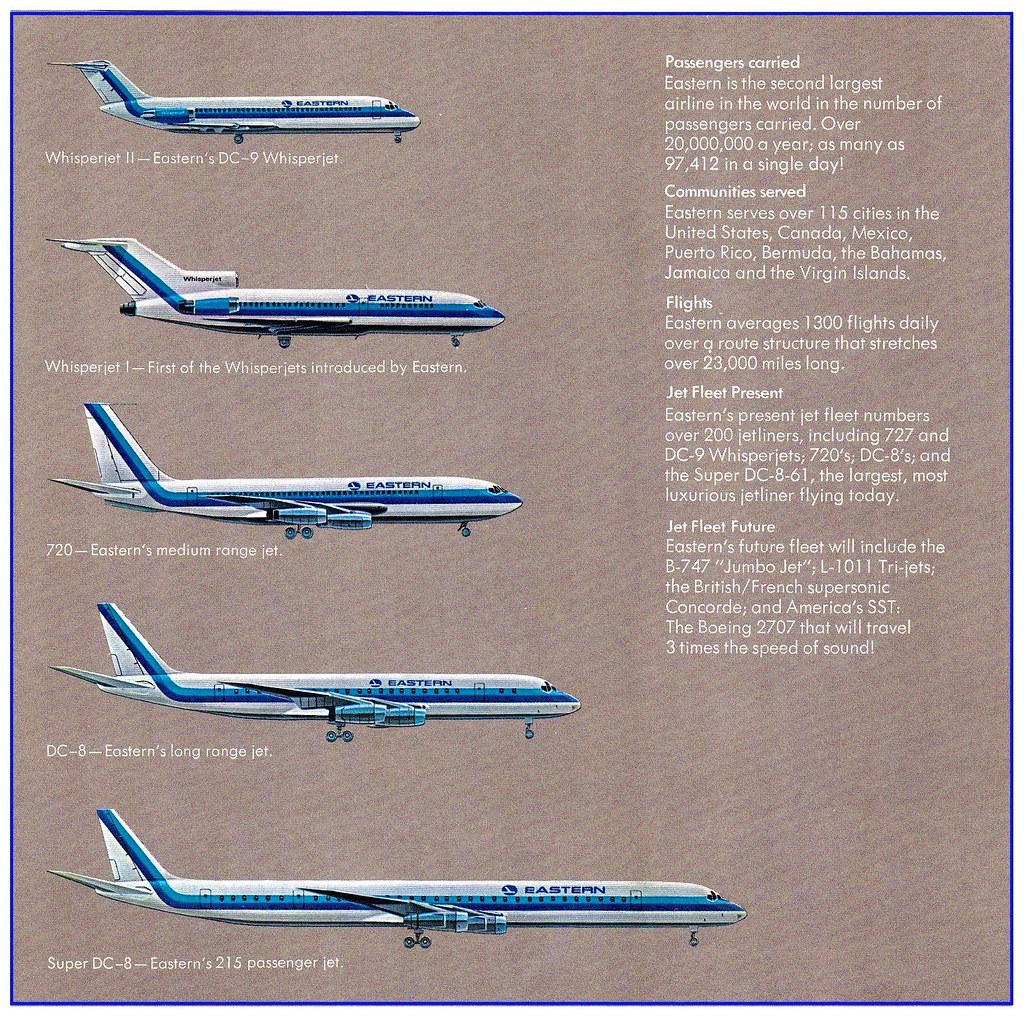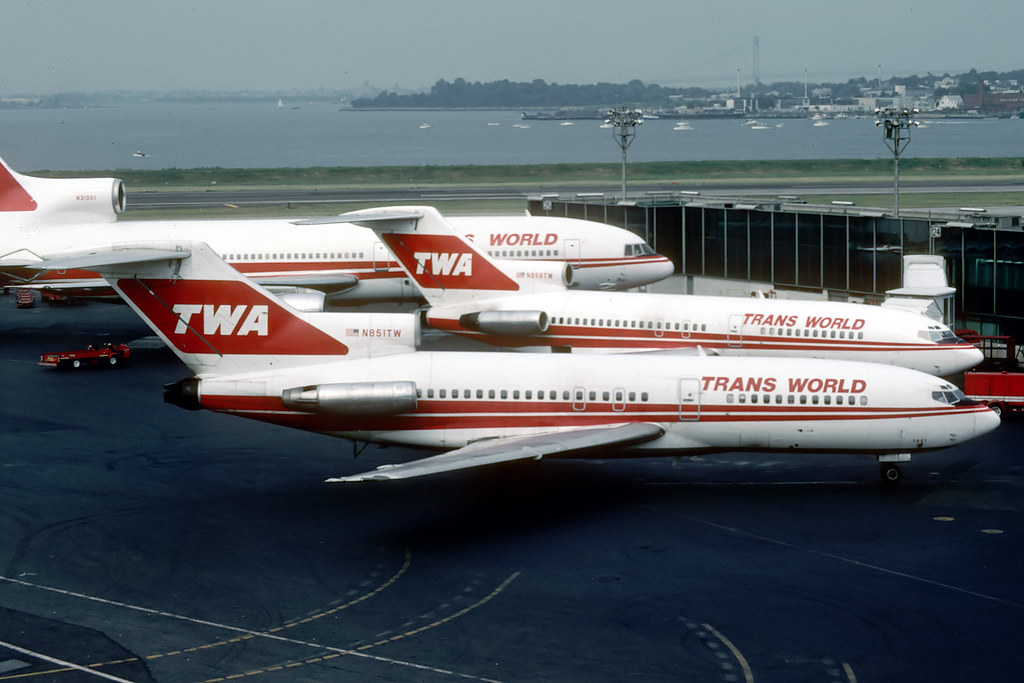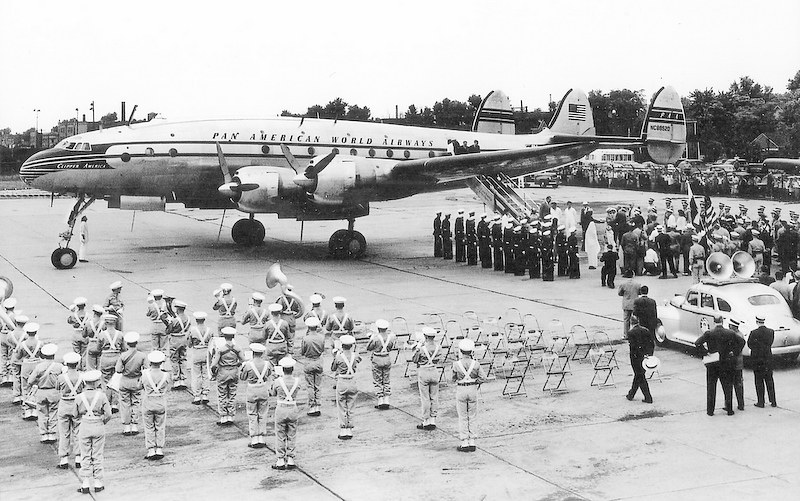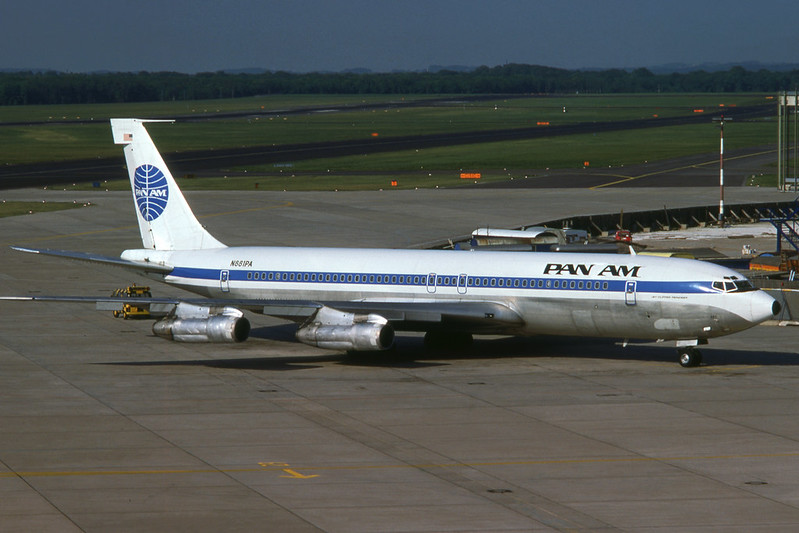Summary
Diogo Montteiro takes a look at some of America’s airlines from the past which are no longer with us.
How many do you remember? Which did you fly on? Leave a comment below.
Braniff International Airways

RuthAS, CC BY 3.0 <https://creativecommons.org/licenses/by/3.0>, via Wikimedia Commons
On June 20, 1928, a single-engine Stinson Detroiter took off from Oklahoma City to Tulsa, covering a distance of 187 km. Thus began Braniff Airways, one of the most successful independent airlines of all time.
The project was started by two brothers from Oklahoma City. A dreamer and a pragmatist, Paul Braniff, a World War I aviator, and his brother Tom Braniff, an Oklahoma City insurance executive.
Established in 1930, the newly created airline soon expanded its routes from Oklahoma City to Wichita Falls, Kansas City and St. Louis. Despite the growth, the airline was in bankruptcy process in 1934, when the Post Office canceled all airmail contracts and offered them to a new bid. Braniff Airways won a contract to transport mail from Chicago to Dallas and soon after bought an airline with a route between Amarillo and Brownsville via Dallas, Texas. In this way, Braniff Airways became the first airline to connect the Great Lakes with the Mexican border.
During World War II, Braniff turned over more than half of its fleet to the US Government for military use and operations. Also, during the conflict, Braniff moved its base of operations from Oklahoma City to Dallas and began flying US Government contracted routes to the Panama Canal Zone. After the war, Braniff Airways began operating to countries such as Peru, Brazil, Argentina and Colombia.
In 1954, Tom Braniff died in a private plane crash and Paul Braniff left the airline soon after. Charles E. Beard was elected president, and an Oklahoma City businessman, Fred Jones became chairman of the board. In 1955, Braniff underwent major route expansion and equipment and fleet upgrades. Finally, serving New York City and Washington D.C., the company acquired Boeing’s 707s and Lockheed Electra and in 1960 was the first airline to exclusively operate jet aircraft. Braniff International Airways gave in to its overexpansion during airline deregulation in the 1970s, ending operations in 1982. Its assets were bought by BIA-COR Holdings of New York, which unsuccessfully tried to resurrect the pioneering airline.
Before its bankruptcy, Braniff had one of the most modern and youngest aircraft fleets in the world.
A planned retirement of older aircraft in conjunction with the addition of approximately eight new jets per year was followed throughout the 1970s. The following fleet is from January 1, 1980.
- Boeing 727-100;
- Boeing 727-200;
- Boeing 747-100;
- Boeing 747-200;
- Boeing 747SP;
- Douglas DC-8-51;
- Douglas DC-8-62 (Long Range Version);
- Aerospatiale-BAC Concorde – (These aircraft were actually owned by Air France and British Airways, but were operated by Braniff crews on a subsonic flight between Dallas and Washington, DC as part of a service exchange agreement between Texas and Europe.)
Its IATA code was BN, ICAO, BNF and its callsign was “Braniff”. By the end of 1979, Braniff had 115 planes, flying to 81 destinations.
Eastern Air Lines
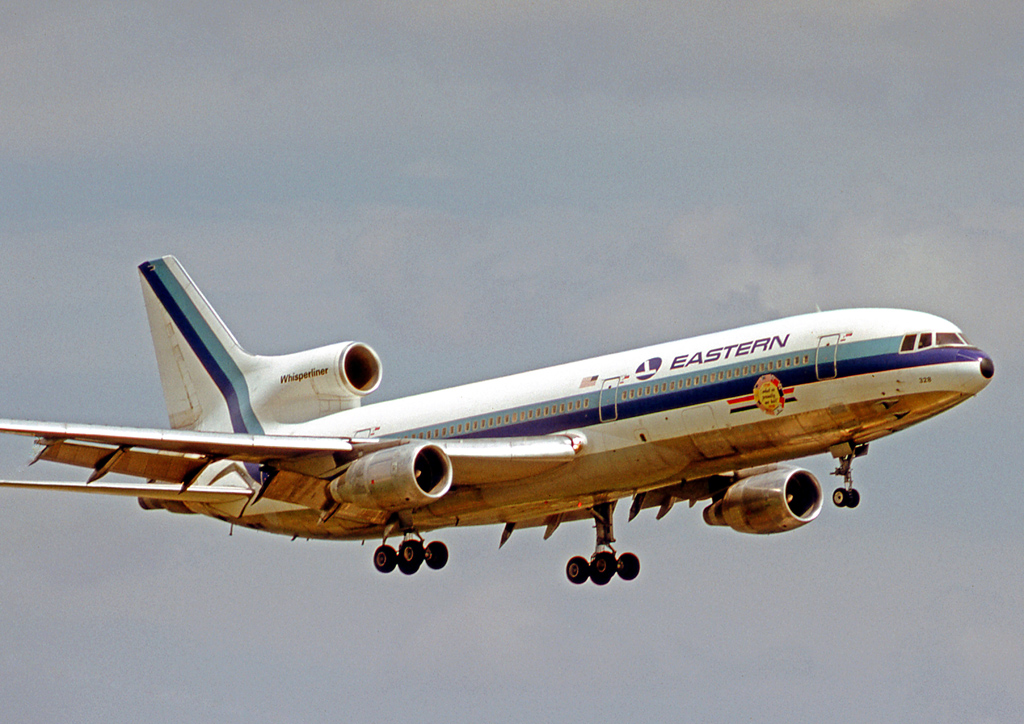
RuthAS, CC BY 3.0 <https://creativecommons.org/licenses/by/3.0>, via Wikimedia Commons
Eastern Air Lines’ origins date back to the late 1920s when the airline began as a simple airmail carrier. At the time, most major US airlines were heavily focused on transcontinental flights. However, the airlines from the West were different, turning to the air connection with the East Coast. Within a few years, the airline had secured several routes from New York to Miami. Its monopoly on East Coast services has attracted high demand from travelers looking to vacation in the Florida
area.
After the end of the war, Eastern Air Lines emerged stronger than ever and ready to continue to expand its monopoly, being the most profitable post-war airline, without ever requesting public subsidies from the US Government.
As the jet age enters, Eastern Air Lines has not been left behind in the race to become a jet engine operator. In 1960, it acquired the first DC-8-21 of an order for 16, and in 1961, it began operating flights with a Boeing 720. The year 1964 saw Eastern become the launch customer for the Boeing 727-100, from which it started to operate a fleet of 75 of the model.
Throughout the 1960s and 1970s, Eastern’s fleet and routes expanded quite rapidly. The company was the launch customer for several other aircraft, such as the Lockheed L 1011-1 Tristar, and was the first US airline to operate the Airbus A300.
However, the late 1970s were difficult for Eastern as Delta’s competition with its new hub in Atlanta sparked a price war that devoured its profits. The deregulation of air transport in 1978 only added to the airline’s financial problems as more and more low-cost airlines began to invade its key market.
The airline struggled to become the launch customer for the Boeing 757, an aircraft that then- President Frank Borman hoped would change the airline’s fortunes. However, with the accumulated debt and the purchase of Airbus A300s, it weighed heavily on the airline’s balance sheet.
At its breaking point, President Borman eventually sold Eastern to Texas Air in 1986. Texas was under the leadership of Frank Lorenzo, who had also recently purchased Continental Airlines. However, shortly after the sale, the FAA fined Eastern the largest fine in aviation history (until 2010, when American Airlines was fined US$24.2 million), charging the carrier US$9.5 million per “security breaches”.
With more money going out than coming in, Eastern was forced to back down from its plans. Employees were laid off and those who remained faced deep cuts in wages and benefits. Labor disputes were rife, leading to costly flight cancellations that lost millions in revenue for the airline.
Eastern Air Shuttle was sold, and eventually later became Trump Shuttle. Eastern Air Lines’ final flight took place on Saturday, January 19, 1991. At its peak, it logged more than 33,000 passenger miles per year and in 1989, it only reached 11,000.
Operating under the IATA and ICAO, EA and EAL codes, respectively, with the callsign “Eastern”, the airline operated with 304 aircraft to 140 destinations.
TWA – Trans World Airlines
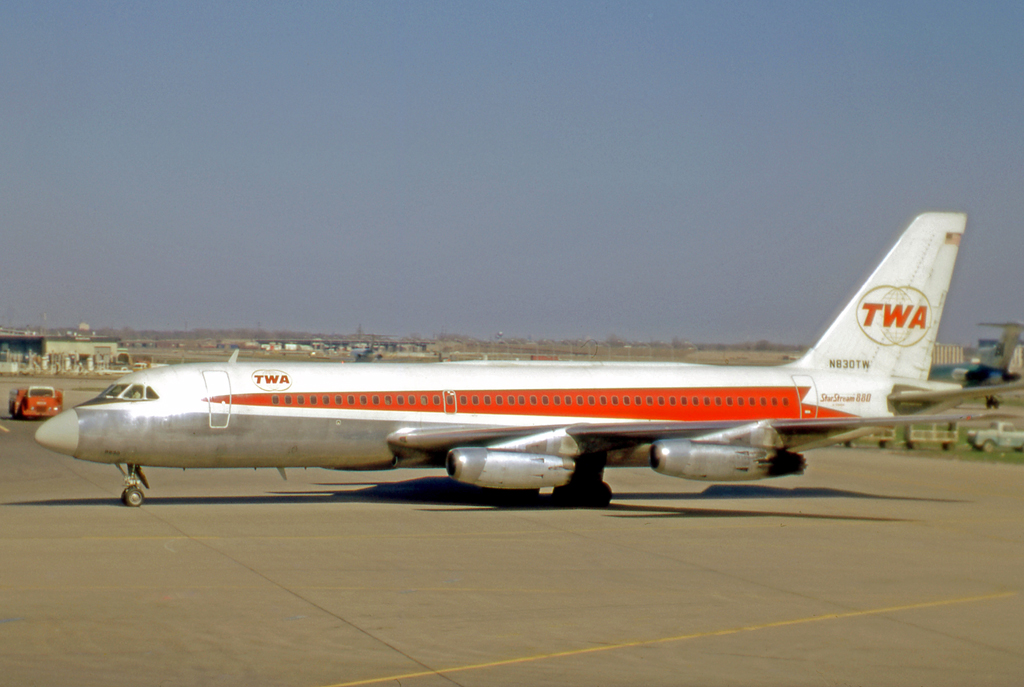
RuthAS, CC BY 3.0 <https://creativecommons.org/licenses/by/3.0>, via Wikimedia Commons
TWA was a former US airline that was founded on July 16, 1930 through the merger of Western Air Express (founded 1925) and Transcontinental Air Transport (founded 1928).
In 1930, TWA inaugurated its service that connected both coasts of the United States between Newark (New Jersey) and Los Angeles in 36 hours, with a stopover in Kansas City, Missouri. In 1934, Western Air Express became independent again (later called Western Air Lines), however TWA continued its operations as an independent and transcontinental airline. Until 1950, TWA was known as Transcontinental & Western Air, Inc.
In 1946, TWA inaugurated international flights between New York City and Paris, expanding rapidly in the 1950s to routes through Europe, the Middle East, Africa and Asia, having between 1969 and 1975 operated flights in the region of the Pacific Ocean.
Financier and aviation pioneer Howard Hughes was TWA’s main shareholder and guiding genius from 1939 until 1960-61, when he lost control of the airline to a group of Wall Street banks and financial institutions that had financed the purchase of jet aircraft for the airline. An antitrust suit was mixed in with the complex civil litigation, and the multiple litigation involved repeated court hearings, in which the lone Hughes refused to appear. In 1966, he sold his shares of TWA for
over $500 million.
TWA restructured under the ownership of a holding company called Transworld Corp. in 1979, but Transworld sold TWA to the public in 1984 in the course of its defense against a threat of hostile takeover. At that time, TWA was in financial trouble, and in late 1985, American investor Carl C. Icahn acquired the airline. In 1986, TWA purchased Ozark Air Lines, Inc., an airline with routes centered in the south-central United States. Although it continued to operate normally, the
airline filed for bankruptcy (to allow for a timely reorganization) in 1992. Despite exiting bankruptcy, the following year, TWA continued to operate at a loss. The flight 800 accident in 1996 further tarnished the airline’s reputation and financial health, and later in January 2001, TWA announced that American Airlines would acquire its assets. TWA officially ceased to exist as an independent airline on December 1st, 2001 when its last flight the TW2 from Honolulu bound for St. Louis landed at 10 PM. Thereafter their IATA and ICAO TW and TWA codes no longer exist.
At the time of its closure, TWA operated to a network of 132 destinations, supported by a fleet of 248 aircraft, which in 2001 was composed of:
- Boeing 717-200
- Boeing 757-200
- Boeing 767-200ER
- Boeing 767-300ER
- McDonnell Douglas MD-81
- McDonnell Douglas MD-82
- McDonnell Douglas MD-83
[Classic Airline Fleets – TWA’s Lockheed Constellations]
Pan American World Airways
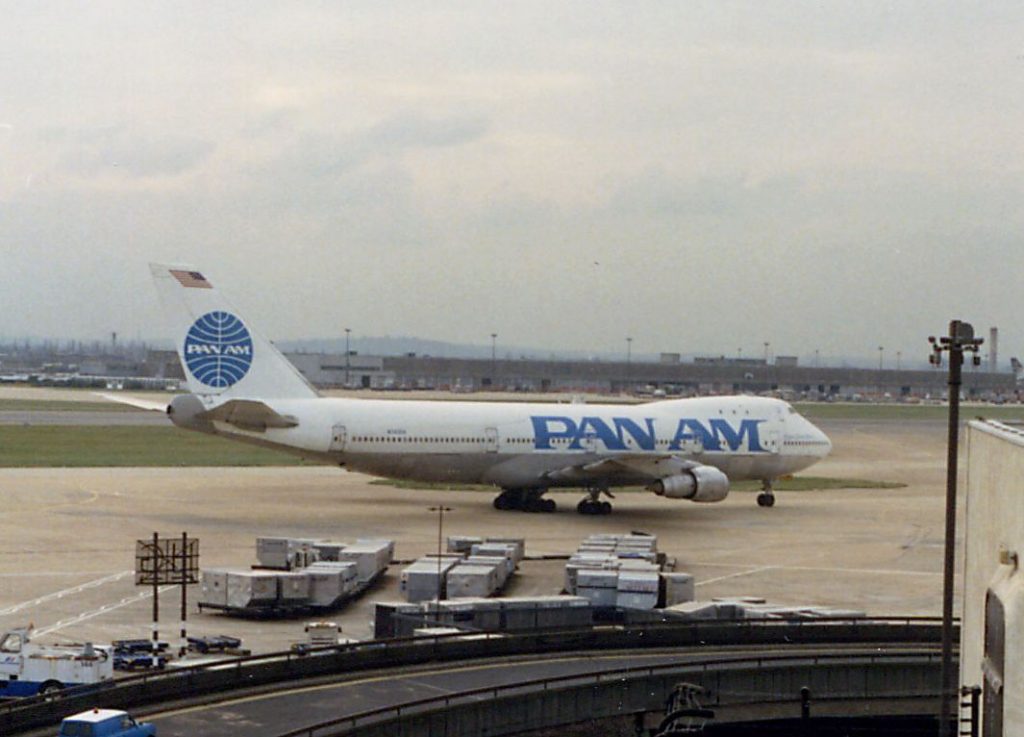
Pan American World Airways, or Pan Am, was founded by two former US Air Force majors. It began as an airmail service between Key West and Havana, Cuba. In 1927 it was the United States first scheduled international flight. Within a year, aviation visionary Juan Trippe took the controls, and Pan Am introduced its first passenger services to Havana. An ad campaign cosponsored by Pan Am and Bacardi successfully encouraged Americans to fly away from alcohol prohibition in the US, to drink rum in the sun in Cuba. And Trippe quickly expanded Pan Am’s network.
By 1930’s, Pan Am was flying routes through most of Central and South America. Crucially, it used a fleet of flying planes, also known as Clippers, to land aircraft on the water at destinations that didn’t have concrete runways for traditional planes on main ground. Since they flew seaplanes, Pan Am pilots use to wore sea Captains’ uniforms, a decision that still influences
aviation uniforms until today. And there were far more important innovations that Pan Am developed in its early days of flight and until today remain all around the world. Everything from things taken for granted today, like ATC and different flight procedures, different ways of forecasting the weather, or even flight planning. The airline actually set a few different records about that. It was also the first to fly from the US across the Pacific.
By 1958, Pan Am offered regular flights to every continent on planet except Antarctica, giving itself the title of “The world’s most experienced airline.” Pan Am’s modern fleet of pressurized aircraft could fly smoothly above turbulent weather, which provided a comfortable experience for passengers. Its lavish cabins were staffed by a multilingual, college-educated cabin crew who served luxurious meals like steak, Champagne, and even caviar.
On October 26, 1958, Pan Am becomes the first American airline to fly jet aircraft. A Pan Am Boeing 707 leaves from New York bound to Paris in eight hours. The world officially enters the jet age through the wings of Pan Am. The powerful new jet engines, allowed Pan Am to introduce daily flights to London and Paris. And with the introduction of economy class, Pan Am opened the world of air travel to tourists, not just the rich and famous people. In 1970, Pan Am carried 11 million customers over 32 billion km. Thinking that air travel would only continue to grow, Pan Am invested half a billion dollars in a large fleet of Boeing 747 jetliners program, but this would turn out to be a big mistake.
In October 1973, the Organization of Arab Petroleum Exporting Countries declared an oil embargo against nations, including the US, that were supporting Israel in the Yom Kippur War.
By the end of the embargo in March 1974, the price of oil had risen by more than 400%. This hit Pan Am harder than other airlines because of its exclusively long-haul flights, which required more fuel. Pan Am was the launch customer for the Boeing 747. At the time, the 747 was a great airplane for the airline to buy but the oil crisis really changed things for Pan Am. It was all of the sudden the wrong plane to have. It wasn’t the most efficient. It was flying routes that really weren’t
selling that well because demand for travel was going down, and that was a very difficult time. While Pan Am’s operating costs skyrocketed, the economy slowed, and America’s appetite for international air travel greatly reduced, leaving Pan Am dangerously overcapacity, with huge, half-empty jets taking to the skies. As a result, between 1969 and 1976, Pan Am lost about US$364 million and was estimated to be $1 billion in debt.
Pan Am had long hoped to add domestic flights within the US to its operation and even talked to a number of domestic operators, including American and United Airlines, to propose a merger. But rival airlines convinced the US Congress that Pan Am threatened to monopolize US aviation, and the Civil Aeronautics Board repeatedly denied Pan Am permission to operate domestically.
But in 1978, the Airline Deregulation Act was passed into United States federal law, meaning the government could no longer control airline routes. Pan Am was now allowed to acquire a domestic system, and it hastily purchased National Airlines for $437 million.
It cost a tremendous amount of money to acquire National Airlines, to get the routes. The airline obviously made a choice. Pan Am couldn’t build from scratch. It needed to go out and buy something. Basically two cultures were going on: Pan Am, very worldly, sophisticated, international. Then, National Airlines. They were sort of puddle jumpers. They were considered
country pilots, so there was a mix of culture that didn’t work there. Plus, the different kind of aircraft, and so mechanics had never worked on certain airplanes. This was a mismatch.. Just in general, it was really a small southern airline that was matching up with an international airline.
Within a year of the National Airlines purchase, Pan Am lost US$18.9 million, even after selling its iconic head office located at 200 Park Avenue in Manhattan for US$400 million. Pan Am continued to self-liquidate to offset its losses. In addition to trading its hotel chains, it sold its entire Pacific division to United Airlines.
But Pan Am still had a global reputation as the flagship US airline. However, this claim to fame would attract a devastating price with the events of the Pan Am Flight 103. On the 21st of December, 1988, Pan Am Flight 103 took off from London – Heathrow bound for New York – JFK. A bomb that had been placed on board accordingly blew up over Lockerbie. 259 people
all aboard the plane were killed, and 11 citizens in the small community of Lockerbie were also killed during the ground impact.
Pan Am were held culpable and negligent in failing to have adequate security measures. At the time in court, in its defense, Pan Am claimed that it had taken the normal security measures that the entire aviation industry did at the time. However, the courts found this inappropriate.
From the judges’ perspective, Pan Am failed to adequately protect the airplane and, as a result, boarded a suitcase that was not supposed to be on board. The Lockerbie bombing cost Pan Am more than US$350 million and proved to be the final blow to the once giant airline. Just two years later, on January 8, 1991, Pan Am filed for bankruptcy.
After the collapse, a bidding war started. Delta Airlines purchased the majority of Pan Am for US$1.4 billion, acquiring its European routes, its northeastern shuttle routes, 45 planes, its minihub in Frankfurt, and its Pan Am Worldport terminal at JFK Airport. Pan Am hoped to emerge from bankruptcy court, but after realizing it was losing $US3 million per day, Delta stopped its cash advances. After failing to raise money from other sources, a phone call was made to Pan Am’s head office on December 4, 1991. The message was: “Shut it down.”
Pan American World Airways went bankrupt, and it shut down its services. This event broke people’s hearts, not just the people that worked for the airline, but for many other people that flew it and knew it. It was the flagship airline of America and it was the materialization of the American dream and progress.
Pan Am, the legendary airline with its legendary logo, was the second most recognized trademark in the world at the time. But Pan Am’s legacy continues to be felt three decades after its collapse. Its innovations remain the pillars of modern air travel. Its brand style has survived throughout the decades as an iconic mid-century fashion statement.
Pan Am operated under the codes of PA and PAA. In 1990, one year before its collapse it had a fleet of 152 airplanes of Airbus A300B4, A310-200, A310-300, Boeing 727-200, Boeing 737-200, Boeing 747-100 and Boeing 747-200.
On December 4, 1991, the airline’s last flight, Pan Am 436, took off from Bridgetown Airport in Barbados to Miami, under the commands of Captain Mark Pyle. The N368PA, a Boeing 727-200, named “Clipper Goodwill” landed at Miami International Airport, closing 64 years of history and legacy for world aeronautical culture. It was the end of the emblematic callsign “Clipper”.
Enjoyed this article? Read more with Airlines from the Past – Europe


